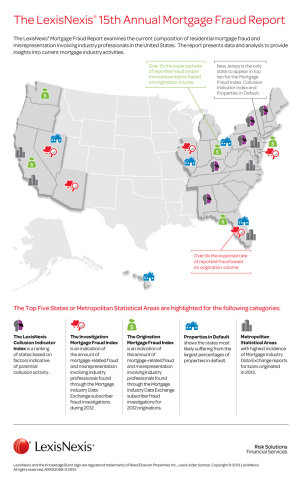ATLANTA--(BUSINESS WIRE)--LexisNexis® Risk Solutions today issued its 15th Annual Mortgage Fraud Report, spotlighting three economic indicators —mortgage fraud and misrepresentation activity involving industry professionals, potential collusion activity, and for the first time, new data showing the volume of properties in default —and their impact on the implosion of the U.S. housing market over the past five years. The LexisNexis Annual Mortgage Fraud Report examines the current composition of residential mortgage fraud and misrepresentation in the U.S. committed by industry professionals, based on data submitted to the LexisNexis Mortgage Industry Data Exchange (MIDEX).
“This year’s study suggests that the more shared problematic economic indicators a state has, the greater its financial challenges will be in the coming years,” said Tom Brown, Senior Vice President, Financial Services, LexisNexis. “With Consumer Financial Protection Bureau (CFPB) mortgage regulations going into effect in January 2014, and demanding new rules for quality loans, it will be interesting to see what impact this has on overall mortgage defaults.”
For a copy of the report click here:
The study highlights state rankings information, including:
- New Jersey was the only state in the study that made it on all three top 10 lists for mortgage fraud and misrepresentation reported to MIDEX, potential collusion and property defaults.
- Five states appear on both the Investigation and Origination Mortgage Fraud Indices (MFIs) and the newly-established list of Property Default Rankings: Florida, Georgia, Illinois, Nevada and Ohio.1
- Ohio, which ranked first on the Origination MFI list, with a ranking of 224, had more than two times the expected rate of fraud or misrepresentation based on origination volume.
- Five states — Arizona, California, Florida, New Jersey and New York — occupy space on both the Investigation and Origination MFIs.
- Eight states — Alabama, Delaware, Iowa, Kentucky, Louisiana, Pennsylvania, New York and Vermont — rank highly on both Collusion Indicator Indices (CIIs) as areas with high percentages of potential non-arm’s length transaction activity.
Analysis of all loans investigated in 2012 and submitted to MIDEX shows a five-year high of 69 percent of all reports received having some type of application misrepresentation or fraud. Similarly, when focusing on just those loans originated in 2012, 61 percent report application misrepresentation and/or fraud. This is up from 49 percent of loans originated in 2011 and 43 percent in 2010.
For the first time in the study, a nationwide aggregation of available LexisNexis property data was used to determine states most likely suffering from the largest percentage of properties in default. Florida and Nevada experienced the most dramatic decreases in properties in default even though they were ranked first and fourth, respectively, on the list for 2012.
The report also examines noticeable decreases in mortgage loan fraud levels. According to the Financial Crimes Enforcement Network (FinCEN), approximately 69,000 Suspicious Activity Reports (SARs) specific to mortgage loan fraud in 2012 were received. This is a 25 percent decrease from those received in 2011. Similarly from 2011 to 2012, 16 percent fewer reports of material misrepresentation involving industry professionals were submitted to MIDEX by subscribers.
The methodology used in the report to calculate the Mortgage Fraud Index (MFI) is based on the volume of fraud and/or misrepresentation involving industry professionals reported to MIDEX for a given state weighed against that state’s overall mortgage loan origination volume. The report utilizes a different methodology to calculate the Collusion Indicator Index (CII) which is based on public record data collected from a separate database than that used to create the MFI. There is no correlation between the MFI and CII data.
About LexisNexis Risk Solutions
LexisNexis Risk Solutions (www.lexisnexis.com/risk/) is a leader in providing essential information that helps customers across all industries and government predict, assess and manage risk. Combining cutting-edge technology, unique data and advanced scoring analytics, Risk Solutions provides products and services that address evolving client needs in the risk sector while upholding the highest standards of security and privacy. LexisNexis Risk Solutions is part of Reed Elsevier, a leading publisher and information provider that serves customers in more than 100 countries with more than 30,000 employees worldwide.
Our financial services solutions assist organizations with preventing financial crime, achieving regulatory compliance, mitigating business risk, improving operational efficiencies and enhancing profitability.
1 States listed in alphabetical order, not rankings.




